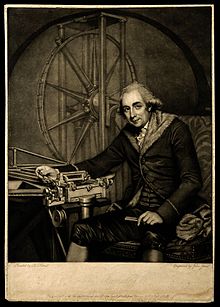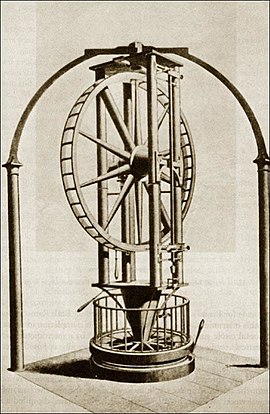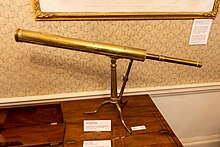Life
Ramsden was born at Salterhebble, Halifax, West Riding of Yorkshire, England the son of Thomas Ramsden, an innkeeper and his wife Abigail née Flather.
Having attended the free school at Halifax from 1744 to 1747, he was sent at the age of twelve to his maternal uncle, Mr Craven, in the North Riding, and there studied mathematics under the Rev. Mr. Hall. After serving his apprenticeship as a cloth-worker in Halifax, he went to London where, in 1755, he became a clerk in a cloth warehouse. In 1758 he was apprenticed to a mathematical instrument maker and he proved so proficient that he was able to set up his own business only four years later. The quality and accuracy of his instruments established his reputation as the most able instrument maker in Europe for the next forty years until his death in 1800.
In 1765 Ramsden married Sarah Dollond, daughter of John Dollond, the famous maker of high quality lenses and optical instruments. Ramsden received a share in Dollond's patent achromatic lens as dowry. Little is known of their life together but Sarah did not accompany him when he moved his workshop (and home). In 1773, Ramsden moved to 199 Piccadilly but Sarah and her son lived at Haymarket at a home belonging to her father's family. At the time of her death on 29 August 1796 she lived at Hercules Buildings, off Westminster Road, Lambeth. She was buried at St Mary's, Lambeth, on 1 September 1796. In his later years he lived above the workshop with a number of his apprentices. The Ramsdens had two sons and two daughters with only one, John, living past infancy. John later became a commander in the East India Company's navy.
Ramsden's dividing engine allowed instruments to be made smaller without loss of measurement accuracy. The rights for a portable sextant designed by Ramsden and used for maritime navigation were purchased by the Board of Longitude in 1777 for £300. An additional £315 was paid to allow for its construction details to be used by other craftsmen. He also received charges for servicing of the instruments.
Ramsden was of a genial disposition, but at the same time infuriated his clients with his tardiness in delivering their purchases, particularly of larger commissions. His three-year delay in providing William Roy with the theodolite for the Anglo-French Survey (1784–1790) provoked a public row within the portals of the Royal Society and in its Philosophical Transactions. Many delays could be attributed to Ramsden's quest for perfection, as he continually refined his designs as the slightest shortcomings were revealed.
Ramsden was elected to the Royal Society in 1786 and to the Royal Society of Edinburgh in (probably) 1798.
The Copley Medal of the Royal Society was bestowed upon him in 1795 for his 'various inventions and improvements in philosophical instruments.’
Ramsden's health began to fail and he traveled to Brighton on the south coast to try to benefit from its better climate, but died there on 5 November 1800. He was buried at St James's Church, Piccadilly on 13 November. His instrument-making business in London was taken over by his foreman, Matthew Berge until his death in 1819. The estate passed on to his son. Many of Ramsden's apprentices such as William Cary went on to establish their own instrument-making ventures. Others like Edward Troughton incorporated ideas from Ramsden into their own designs.


